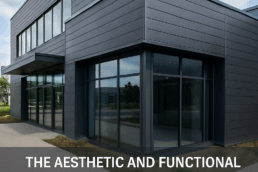Different metals are used in fabrication for various construction applications. In the construction industry, common metal fabrication materials include steel, aluminum, stainless steel, and copper. Each of these metals brings distinct advantages to the table based on their properties.
Whether it’s the unparalleled strength of steel, the lightweight nature of aluminum, the corrosion resistance of stainless steel, or the conductivity and aesthetic appeal of copper, selecting the right metal is critical for achieving optimal results in construction projects. This blog discusses the most common metal fabrication materials used in the construction industry and their characteristics.
Construction Metal Fabrication Materials
1. Steel
Steel is one of the most widely used metal fabrication materials in the construction industry. Its strength and versatility make it an essential component in numerous structural applications.
- Durability
Steel is renowned for its durability. It can withstand substantial stress and weight, making it ideal for structural applications. Its high tensile strength ensures that buildings and other structures can endure harsh weather conditions and heavy loads without compromising integrity. This durability translates to long-lasting constructions, reducing the need for frequent repairs and maintenance.
- Versatility
Steel’s versatility is unmatched. It is used in constructing beams, columns, trusses, and frameworks for buildings and bridges. Additionally, it can be easily fabricated into different shapes and sizes to meet specific project requirements. This adaptability makes steel a go-to material for architects and engineers aiming to create innovative and resilient structures.
2. Aluminum
Aluminum is another popular metal fabrication material in the construction industry, known for its lightweight nature and excellent corrosion resistance.
- Lightweight
One of aluminum’s primary advantages is its lightweight nature. Weighing significantly less than steel, aluminum is perfect for applications where weight is a concern. This characteristic is particularly beneficial in constructing high-rise buildings and bridges, where reducing the overall load can enhance safety and efficiency.
- Corrosion Resistance
Aluminum is highly resistant to corrosion. This quality makes it suitable for exterior applications where exposure to the elements is inevitable. It forms a protective oxide layer when exposed to air, preventing further oxidation and degradation.
3. Stainless Steel
Stainless steel is celebrated for its aesthetic appeal and excellent corrosion resistance. It’s a preferred choice for both structural and decorative applications in construction.
- Aesthetic Appeal
Stainless steel offers a sleek and modern look. It has become a popular choice for decorative elements in construction. Its shiny and polished appearance can enhance the aesthetic appeal of buildings, bridges, and interior designs. Architects and designers often use stainless steel for handrails, cladding, and other visible elements to achieve a contemporary and sophisticated look.
- Corrosion Resistance
Similar to aluminum, stainless steel is highly resistant to rust and corrosion. This makes it suitable for environments exposed to moisture and other corrosive elements. Its durability and low maintenance requirements further enhance its appeal and make sure that structures remain sturdy and visually appealing for extended periods.
4. Copper
Copper is a versatile metal fabrication material known for its excellent conductivity and distinct aesthetic appeal.
- Conductivity
Copper is unmatched in its electrical and thermal conductivity. It’s a material essential for various electrical applications in construction. It is widely used in wiring, electrical components, and heating systems. Copper’s ability to conduct heat efficiently also makes it a preferred choice for plumbing and HVAC systems, where efficient heat transfer is crucial.
- Aesthetics
Copper’s distinct appearance adds a unique aesthetic element to construction projects. Over time, copper develops a natural patina for a classic look. This characteristic makes it a popular choice for roofing, cladding, and other decorative elements. The natural aging process of copper adds character and enhances the visual appeal of structures.
Knowing the most common metal fabrication materials and their characteristics can help in selecting the right material for your construction project. Steel, aluminum, stainless steel, and copper each offer their own benefits and are suitable for specific applications. Steel’s strength and versatility, aluminum’s lightweight and corrosion resistance, stainless steel’s aesthetic appeal and durability, and copper’s conductivity and distinct appearance provide a range of options to meet various construction needs.
When planning your next construction project, consider the specific requirements and benefits of these metal fabrication materials. Each metal has its strengths. Choosing the right one can enhance the durability, functionality, and aesthetic appeal of your project.
At C&J Metal Products, we specialize in custom metal fabrication. Contact us today to discuss your project requirements and discover how our expertise can help you select and utilize the best metal fabrication materials for your construction endeavors.



